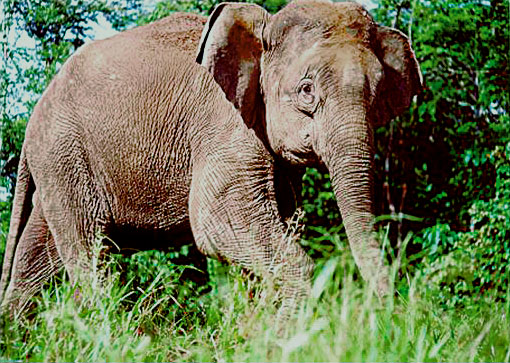- Borneo Elephant
Taxobox
name = Borneo Elephant

status=CR
regnum =Animal ia
phylum = Chordata
classis =Mammal ia
ordo =Proboscidea
familia =Elephantidae
genus = "Elephas "
species = "E. maximus"
subspecies = "E. m. borneensis"
trinomial = "Elephas maximus borneensis"
trinomial_authority =Deraniyagala ,1950 The Borneo Elephant, also called the Borneo Pygmy Elephant, ("Elephas maximus borneensis") is a
subspecies of theAsian Elephant and found in northBorneo (eastSabah and extreme northKalimantan ).Origins
The origin of Borneo elephants is controversial. Two competing hypotheses argued that they are either indigenous, or were introduced, descending from elephants imported in the 16th–18th centuries. In
2003 ,mitochondrial DNA research has discovered that its ancestors separated from the mainland population during thePleistocene , about 300,000 years ago. The subspecies currently living in Borneo possibly became isolated from other Asian elephant populations when land bridges that linked Borneo with the otherSunda Islands and the mainland disappeared after theLast Glacial Maximum , 18,000 years ago. Fernando P, Vidya TNC, Payne J, Stuewe M, Davison G, et al. (2003) DNA Analysis Indicates That Asian Elephants Are Native to Borneo and Are Therefore a High Priority for Conservation. PLoS Biol 1(1): e6 [http://biology.plosjournals.org/perlserv?request=get-document&doi=10.1371/journal.pbio.0000006 Full text] ] Isolation may be the reason it has become smaller with relatively larger ears, longer tails, and relatively straighttusk s. Other scientists argue that the Borneo elephant was introduced by the Sultan ofSulu and abandoned, and that the population on Sulu, never considered to be native, was imported fromJava . Thus the Borneo elephant actually may be the extinct Javan elephant. Many facts support this hypothesis, including no archaeological evidence of long term elephant habitation of Borneo, a corroboration in folklore and the lack of the elephants colonizing the entire island of Borneo. [ [http://www.sciencedaily.com/releases/2008/04/080416223340.htm Presumed Extinct Javan Elephants May Have Been Found Again - In Borneo ] ]Description
The Borneo elephant is smaller than all the other subspecies of the Asian elephant. The Borneo elephant is also remarkably tame and passive, another reason some scientists think it was descended from a domestic collection. Fernando P, Vidya TNC, Payne J, Stuewe M, Davison G, et al. (2003) DNA Analysis Indicates That Asian Elephants Are Native to Borneo and Are Therefore a High Priority for Conservation. PLoS Biol 1(1): e6 [http://biology.plosjournals.org/perlserv?request=get-document&doi=10.1371/journal.pbio.0000006 Full text] ] [WWF News. 2003. New elephant subspecies discovered. WWF - the environmental conservation organisation. Downloaded at 20 August 2006 from [http://www.panda.org/news_facts/newsroom/news/index.cfm?uNewsID=8601 this online publication] ]
Conservation status
Wild Asian elephant populations are disappearing as expanding human development disrupts their migration routes, depletes their food sources, and destroys their habitat. Recognizing these
elephant s as native to Borneo makes their conservation a high priority and gives biologists important clues about how to manage them. [Fernando P, Vidya TNC, Payne J, Stuewe M, Davison G, et al. (2003) Borneo Elephants: A High Priority for Conservation. PLoS Biol 1(1): e7 [http://biology.plosjournals.org/perlserv/?request=get-document&doi=10.1371/journal.pbio.0000007 Full text] ]In August 2007 it was reported that there are probably not more than 1,000 pygmy elephants left in Sabah, after a two year study by the
World Wildlife Fund . [Fewer pygmy jumbos now. Ruben Sario, The Star, Aug 10, 2007. [http://www.thestar.com.my/news/story.asp?file=/2007/8/10/nation/18548848&sec=nation] ]ee also
*
Pygmy elephant
*Insular dwarfism References
Wikimedia Foundation. 2010.
